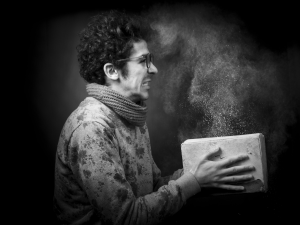Dust surrounds us, finding places in our homes, cars and work settings. But there are times where we are a lot more exposed to dust than others and this can cause people concern. You might be worried about what happens if you inhale lots of dust.
Inhaling lots of dust can cause lung conditions such as pneumoconiosis to develop and need long-term treatment. A person can experience shortness of breath, tightness in chest, fevers and fatigue. Dust particles break down the immune system over time which leaves people susceptible to other diseases.
The more serious outcomes from inhaling dust occur from constant exposure. Let’s take more of a look at the effects and information about inhaling lots of dust.
What are the effects of inhaling lots of dust?
 Inhaling lots of dust can have a range of effects on your health, from coughing to reduced lung function. Large dust particles cause irritation for your eyes, nose and throat. Dust can trigger hay fever, inflaming your mucous membrane and affecting your airways. It can become harder to breathe through your nose.
Inhaling lots of dust can have a range of effects on your health, from coughing to reduced lung function. Large dust particles cause irritation for your eyes, nose and throat. Dust can trigger hay fever, inflaming your mucous membrane and affecting your airways. It can become harder to breathe through your nose.
Lots of dust can also cause tracheitis and bronchitis because the particles can inflame your trachea and bronchi.
If you have asthma, you can experience more frequent attacks from inhaling lots of dust. You will experience wheezing, coughing and shortness of breath.
Inhaling particles smaller than 2.5 micrometres in aerodynamic diameter can result in dust getting into your bloodstream. This can lead to dust particles affecting your kidneys, heart and brain. Serious health issues can occur from this and can potentially lead to heart failure.
For people who are exposed to lots of dust for an extended period of time, there is a high possibility that hypersensitivity pneumonitis will develop. This is a hypersensitive response to particles in the dust, and it can cause coughing and shortness of breath. If these dust particles infiltrate your lungs, your immune system will try to fight them off which can cause inflammation. But if the exposure is over a time period, like breathing in construction dust from the worksite, your lungs will start to build up scar tissue. This can make it harder to breathe and also continue to weaken your immune system. Sometimes dealing with dust is inevitable, especially when working in construction. But you can start reducing the amount of dust by using quality bricklaying and masonry tools designed to deal with dust.
How do I know I’ve inhaled too much dust?
There are three different levels of dust inhalation symptoms that can be used to figure out if you’ve inhaled too much dust. All levels can have the same symptoms which is why it is important to consult with a doctor to figure out the severity of your dust inhalation.
The acute level doesn’t last for long and can feel as though you have caught the flu. You can experience coughing, shortness of breath, tight chest, sweating, tiredness, fever, and chills. These symptoms should pass in a matter of days if you avoid breathing in more dust.
Subacute dust inhalation occurs from low-level dust contact over time. The symptoms will start with a fever and can gradually get worse with time. You can experience tiredness, shortness of breath and coughing at a more severe level.
Chronic effects of inhaling too much dust occur after long periods of dust exposure. These are the most common effects for construction workers who are working around dust constantly. Symptoms include shortness of breath, tiredness, coughing and weight loss. These symptoms will also become worse gradually. You need to seek professional medical attention for this.
Below is a quick table reference for symptoms of acute, subacute and chronic symptoms of dust inhalation:
| Acute | Subacute | Chronic | |
| Coughing | √ | √ | √ |
| Shortness of breath | √ | √ | √ |
| Tight chest | √ | √ | √ |
| Sweating | √ | √ | √ |
| Tiredness | √ | √ | √ |
| Fever | √ | √ | √ |
| Chills | √ | √ | √ |
| Weight loss | √ | ||
| Fatigue | √ | ||
| Limb swelling | √ | ||
| Excess mucus | √ |
What should I do if I inhale lots of dust?
If you have inhaled lots of dust and show the symptoms we’ve discussed, you should consult your doctor. They will help identify the severity of the dust inhaled. From there, they can prescribe you the best treatment method which might include medication or oxygen therapy.
For more acute cases, sometimes drinking green tea helps by reinforcing cells in your lungs. It can reduce the irritation of your lungs if you are only experiencing mild symptoms.
If you are having difficulty breathing, you need to seek medical attention and advice. Follow your asthma action plan if you have asthma.
Anyone with Chronic Obstructive Pulmonary Disease (COPD) or other chronic lung conditions should follow their action plan. Keep taking prescribed medications and talk to your doctor if your symptoms don’t improve.
Dust inhalation can have serious effects on your health which is why getting a consultation done is so important.
How do I prevent myself from inhaling lots of dust?
The best way you can prevent yourself from inhaling lots of dust is to wear respiratory face masks in areas that pose a dust threat. The most common places where dust inhalation can be a major threat are construction sites, mines, and deserts. There are actions in these places that constantly can stir up dust. For example, dust from cutting with an angle grinder, or running through a desert, or chipping at dirt in the mines. In all these environments, you should be wearing protective clothing to act as a barrier to the dust. Masks are important to stop dust from getting into your airways.
Respiratory masks are the best mask option because they have air filters built into them. These filters are designed to protect you from as much dust as possible. But there are some dust particles that can still manage, at times, to get through the barriers.
Building sites should invest in dust filtration systems that collect and filter out dust particles from the workspace. You can also use dust wetting methods to stop most construction dust from becoming airborne.
You should always be sure to properly clean yourself and your clothes after working around dust. Do this before eating or drinking anything. This way you wash away as much dust as possible before it gets a chance to sneak into your airways. The same goes for your workspace. Give it a thorough clean with water-based methods to trap dust and remove it.
You should always invest in a heavy-duty floor scraper to help with dust clean-up, plus a poly fibre brush for brick cleaning when working with brick. We hope this article has helped you out with your dust inhalation queries. On top of providing valuable masonry tools, Paragon Tools Ireland has plenty more useful construction information in our resources!



